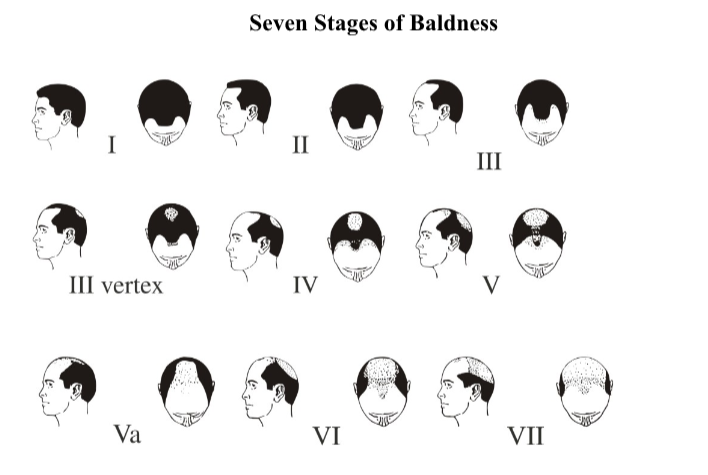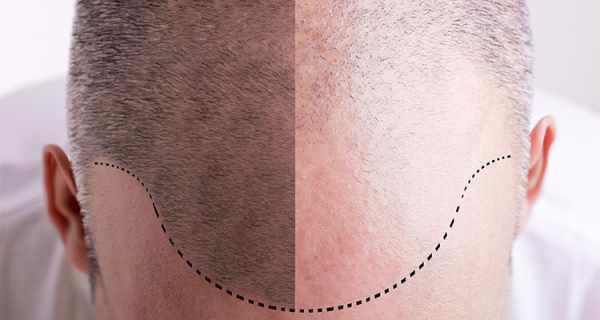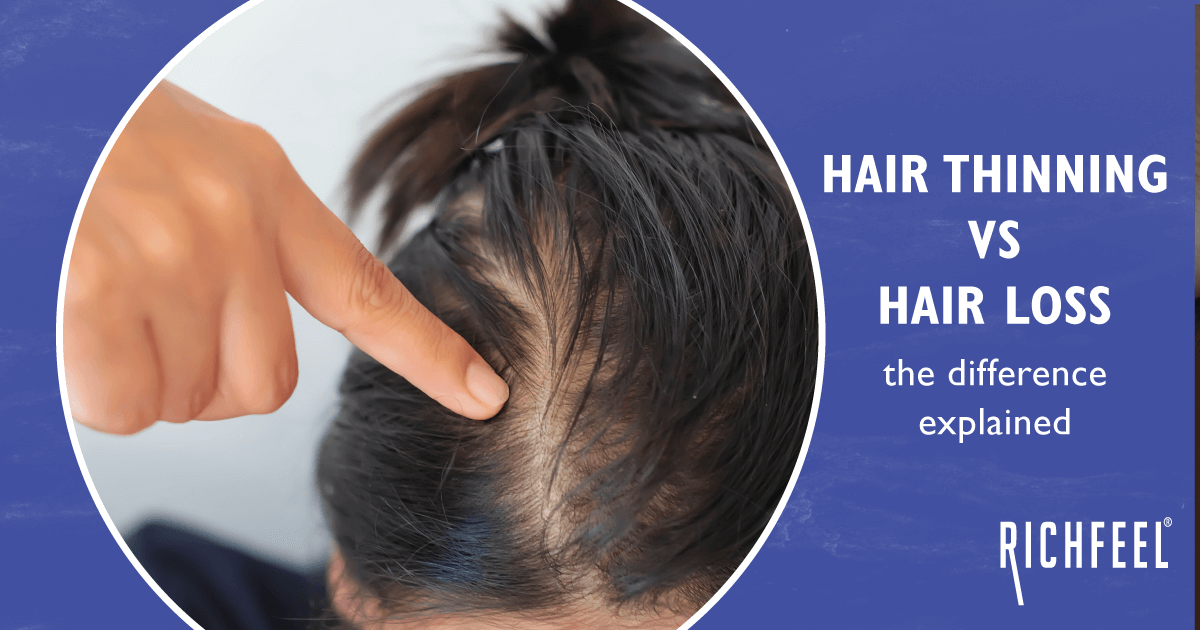The term Alopecia refers to hair loss. There are various kinds of alopecia that one may suffer from; from mild to severe. Male Pattern Thinning (MPT) or Androgenetic Alopecia is the most common form of hair loss in men. It relates to the genetic structure and hormonal activity in the body. Male pattern thinning is characterised by a receding hairline or hair loss on the top of the head. Male pattern hair loss affects approximately 50% of men at some point in their lives. It affects different populations at different rates, probably because of genetics. For instance, up to half of male Caucasians will experience some degree of hair loss by age 50, while other population groups such as Japanese and Chinese men are far less affected. In India, recent studies have shown that men as early as in their 20s are starting to have receding hairlines.
Italian scientist Dr Falvio Ferrari, says ‘While genetics plays a key role in balding, a stressful lifestyle can play havoc.’ Trichologist Dr. Apoorva Shah, India’s pioneer of Trichology, also an associate of Dr.Ferrari, has always said that Hair is the body’s barometer indicating good health or the lack of it. While it’s normal to lose between 50 and 100 strands of hair a day, serious hair loss — medically termed alopecia — is a sign that something is wrong with our body, says Dr Apoorva Shah. “As a reaction to an incident of extreme mental or physical stress, the body typically sheds hair after a gap of three months. For instance, if you are down with food poisoning, the mal-absorption of nutrients during this period can lead to hair loss in the next few months. So, it’s important to jog your memory to pinpoint the cause.”
What are the causes of hair loss in men? What really happens in the process, how do you spot the signs and what are your options to solve it? Lets deep dive to understand this in detail.
Hair loss in men
The most predominant cause for hair loss in men is a genetic trait. This is followed by erratic lifestyle, physical & mental stress, unhealthy eating habits, harsh chemical treatments, heavy medications and improper hair care. Acute illnesses also leads to hair loss and kickstart the thinning process in some who are not otherwise predisposed genetically to baldness.
What happens in Male Pattern Thinning?
Male pattern baldness is one of the most common causes of hair loss in men. Worldwide, almost 62% of men in the age group of 20 to 40 years report a significant loss of hair. Male pattern baldness begins with a loss of hair from the front or crown area and follows a typical pattern.
With each new hair cycle, the affected hairs do not grow as long, and they become finer in diameter; hence the distance between the hair increases and the width of the hair reduces, and the length of the hair shortens visually giving the effect of thinning of hair or baldness.
What are the symptoms of Male Pattern Thinning?
Pattern hair thinning or baldness in men is a progressive condition that can be traced through seven stages as shown below.

The early symptoms of MPT that can be verified by a Trichologist, by doing the hair & scalp analysis are
A. Receding Hairline
B. Reduced follicular count
C. The distance between the hair follicle increasing
D. The diameter of the hair decreasing
E. Length of the hair shortening
Why does this happen?
Blame it on the male hormone androgen. On achieving puberty, the male hormone androgen starts flowing freely in the body in the post-pubescent stage. Ironically, it is the same hormone which destroys the hair follicles in those who are genetically predisposed to baldness. Hair does not attain optimum length & thickness in such cases and the exogen phase gets elongated. Eventually, the follicle loses its capacity to generate new hair.
The person begins to go bald and is diagnosed to be suffering from Male pattern thinning. Unfortunately, one can not tamper with one’s genes or take anti-male hormones to destroy the male hormones; hence there is very little chance of hair regrowth in MPT.
The earlier you detect, the better you can handle it. Your trichologist is the best person to detect what kind of hair loss you are facing, whether it is reversible or irreversible, and help you understand in which stage of baldness you are at and advise the right course of action.
Who is at risk of Male pattern thinning?
MPT can come from either parent. For a male, if his father exhibits Male Pattern Thinning, there is at least a 50% chance that he will also show it. Having said that, just because the father is bald, doesn’t mean the son would have the problem, and just because both parents have lovely hair does not mean that the son won’t have the problem. The other important factor is high testosterone in men can trigger off male pattern thinning.
Can Hair loss in men be cured?
The treatment for Male Pattern Thinning is traditionally based on the principle of postponing and delaying the progress of baldness.
It consists of two lines of treatments a) Pharmaceutical DHT blockers OR b) The use of natural DHT blockers.
Patients using pharmaceutical DHT blockers may exhibit signs of sexual dysfunction. Hence, more and more Trichologists are encouraging the use of natural DHT blocker treatment.
Trichologist world over has seen dramatic results with the use of green tea and saw palmetto for baldness. The medicine Serenoa Complex comprises of saw palmetto which reduces the production of DHT from Testosterone, thereby helping to slow down the process of balding.
One of the breakthrough solutions that have come by in recent years is a therapy that is the world’s first hair fertility therapy. In the science of Trichology, MPT is considered irreversible, since it leads to permanent loss of hair follicles. But with the introduction of this therapy for hair loss, there has been a dramatic twist in the approach towards the problem. It not only controls hair loss but also fights hair thinning!
Anagain is a revolutionary treatment which is the brainchild of World’s leading Trichologist & RichFeel Founder Dr. Apoorva Shah, in collaboration with Mibelle Biochem & Biotech Italia. It is a unique treatment which is a breakthrough, advanced solution for hair thinning & hair loss in men.
A truly revolutionary & unique offering pioneered at RichFeel, it packs the punch of two powerful ingredients together – Pea plant sprout extracts, a proven source of improving the ratio of anagen (growth phase of hair) to telogen (the resting phase of hair) & RootBioTec HO – an extract from basil that inhibits 5α reductase and stimulates hair follicles.
The other options available to someone dealing with MPT are hair transplant and/or use of hair systems, which are highly evolved and lets you follow your lifestyle as is – no compromises.
Hair transplant is a way of permanent hair restoration Hair transplantation is a surgery that moves hair and hair follicles from a part of your body called the donor site to the bald or balding part called the recipient site. It is done with the help of a scalpel or punch graft instrument. The removed hair strands from one part of the body are placed into tiny holes of the bald scalp. Do read our blogs on the topic to understand all about hair transplants.
Hair Systems are the way to restore hair on head non-surgically. Non-surgical hair replacement procedure allows you to achieve a head full of hair that looks natural, stylish and does not restrict your lifestyle. Understand Hair systems better by catching up on our blogs on the subject.
Thus, there are multiple options available. Sometimes, a simple change in lifestyle alone could help curb the problem of hair loss a great deal. Dr Ferrari squarely explains. “Simple lifestyle changes such as, getting seven hours of sleep, having a glass of water every hour (strands are made up of minerals, which only water can replenish) and eating protein-rich foods at regular intervals can bring about an 80 percent change.”
“Nutrition is vital for hair growth. No other part of the human body grows at the rate of half an inch per month, except bone marrow, so you must feed it,” says trichologist Dr Shah.
Together the experts put hair loss down to four major reasons: stress, vices, pollution and poor nutrition. Pay attention to these, review your lifestyle, eat right, care for your hair right and you have solved a chunk of your hair issues. Not just that, you can actually have healthy hair.
What is important, is that you are aware of what the problem is, the underlying cause to the concern, and you seek help from the right professionals to solve it the right way. If you want to make an informed choice, get in touch with the true Hair expert, a Trichologist!



